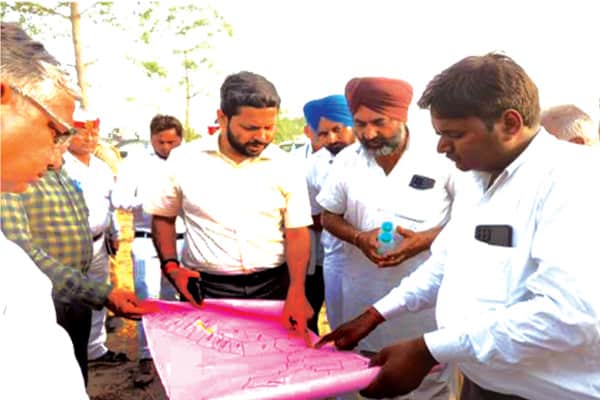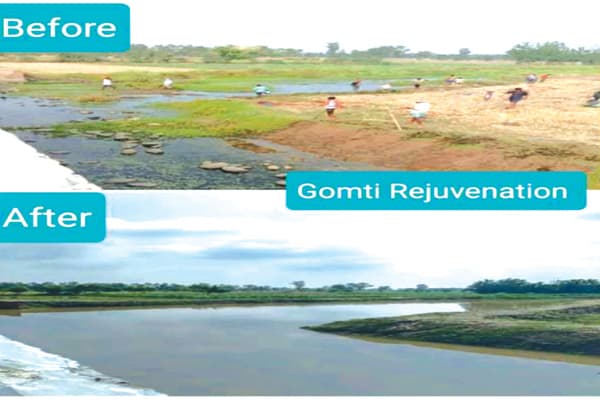
Over 20 major towns of Uttar Pradesh depend on river Gomti for drinking water and agricultural requirements. Originating as a groundwater fed river in Pilibhit district in the terai region of Uttar Pradesh, the river travels 960 kms before meeting Ganga in Ghazipur district in Eastern UP. However, the river was on the verge of dying a slow death due to a variety of factors like siltation, weed growth, encroachments and lack of ownership, before a mega rejuvenation project was launched by Pilibhit district administration under the leadership of Pulkit Khare IAS, then District Magistrate, Pilibhit. Pulkit writes about the initiatives he undertook to rejuvenate the river.
The importance of river Gomti, a prominent tributary of river Ganga, is known to one and all. Over 20 major towns of Uttar Pradesh in the catchment basin of the river derive their drinking water supply from the river, while lakhs of farmers depend on the river for their agricultural produce. From a quiet origin as a groundwater fed river from the Gomat taal or Fulhar Jheel in Madhotanda panchayat of Pilibhit district, the river travels a distance of around 960 kilometres in the state before meeting river Ganga at Saidpur in Ghazipur district.
A recent report, based on the survey conducted by an eminent university, published in the Indian Journal of Ecology, stated that Gomti’s flow is in ‘danger’.


The challenges
The journey in the district of origin is only about 47 kilometres before the river silently enters the neighbouring Shahjahanpur district. In this initial course, Gomti passes through 16 gram panchayats. However, this entire stretch was marred with obstacles. The flow was highly intermittent and patchy and there was no semblance of a river when we first surveyed the stretch in April 2022. There were multiple issues like encroachments, siltation, growth of weeds and lack of ownership. While the problems were scanty and simple in some, they were complex in others. were the major problems to begin with. A plan was chalked out to tackle each issue in a holistic manner. A gram panchayat-wise map was prepared by combining the traditional wisdom and the available revenue records. Village-level functionaries were taken on board and meetings with lekhpal and village secretary from each gram panchayat was held to identify the issue as well as the roadmap for solution.


Being in the terai belt, the groundwater level was never a problem but the challenge was to rejuvenate and establish the stretch as a continuous flowing river. The river was hardly in existence. It was just patches of water, dying a silent death.
Action plan
After identifying the silted stretches and encroached patches in every village, a meeting of gram pradhans and all other village level functionaries was called by the district administration. An emotional appeal was made to one and all, asking them to work jointly for revival of the river.
A mega-project under MGNREGA scheme was designed whereby work would proceed simultaneously in all 16 gram panchayats. Getting sufficient labour for the mega project was a challenge as the desired rejuvenation (widening and deepening) work had to be completed before the monsoons. So, labourers were identified in each village. Choupals were held in villages to enlist labourers and issue muster rolls. Date for shramdaan in all 16 panchayats was decided to formally launch the project.

Finally, the Gomti river rejuvenation work started on May 11 this year. The joy was palpable. I formed a WhatsApp group to get photographs of work and the number of labourers employed on work sites from each gram panchayat on a daily basis.
However, it began to ebb from the very fourth day itself. The numbers of labourers turning up at the work site started falling. This was worrisome as consistency was needed for timely finishing the project. It was time to rethink the strategy. This was when the idea of padyatra (footmarch) struck me.
I decided to travel the entire course of the river to supervise the quality of work.
Each day, I, alongwith a team of officials would travel a few kilometres to inspect the quality of work of Gomti river rejuvenation, talk to pradhan, village functionaries and villagers who would join me in hourly inspection-cum walk along the course of the river. I could not only see the quality of work and the challenges first hand, but could also gather a lot many solutions from the local wisdom of the villagers. Many other problems of the village were discussed and solutions were delivered during the walk, as all officers related to the village were part of the convoy undertaking the padyatra. Each day, the padyatra would begin from where it culminated the previous day.

Gradually, the labour turnout started improving as the village functionaries held choupals in villages to convince villagers about the sanctity of this pious work, despite prevailing higher daily wage rates for manual labour. The pressure of padyatra-based inspection ensured that numbers did not fall in either shift of the day during the entire project. An average of over 3000 labourers worked daily for 51 days on this rejuvenation project.
While digging to widen and deepen the channel was supported by high ground water levels of terai and the rich soft alluvium soil, huge daunting stretches of weeds gave tough time to the labourers. Emergence of snakes during the work also sent panic across for a few days. Teams from the forest department were deployed at the work site to catch any dangerous reptile or insect. The work progress stabilised to a decent pace.

Building sustainability
As the problems identified were recurring in nature, elements of sustainability were essentially introduced as part of the project. Labourers were given details of the slope profile expected to be achieved during the work of rejuvenation, to enable a healthy gradient for maintaining the river flow. Farmers with lands adjoining the river were identified from revenue records and I held a separate meeting with them. As a result, none of the ‘encroaching’ farmers objected to rejuvenation efforts of improving upon the width of the river channel. Simultaneously, the identified 513 farmers with fields adjoining the river were trained in methods of natural farming to reduce chemical pesticides and fertiliser run offs falling into the river. Workshops and field visits were conducted for them to inculcate best practices in natural farming. Pumps were discouraged in these fields while trenching was encouraged.

Dr Krishnaswamy, a renowned hydrologist, was taken on board as advisor for this rejuvenation project as he could provide technical advice as a specialist about the sustainability of this project. He advised that reducing the run-off from fields would help in controlling the growth of weeds, which had arrested the river flow for a significant length. Survey was also done to ensure that no drains or industrial waste empty themselves into the river at any point during its course in the district. Grass-carp, a variety of fish, was introduced throughout the river to arrest the weeding process and strengthen the element of sustainability. Illegal fishing was banned and strict vigil on such ecologically damaging activities was enforced by the police department.
However, high mass of silt from deepening and widening work soon started piling up. This could have fallen back into the river resulting in nullification of the rejuvenation efforts. Their timely removal from the site to flatten the banks was essential. On other hand, there was demand by several government schools for silt for filling up their grounds, as they had been facing water-logging issues during rains. Both the issues were inter-linked. Each village secretary was given a list of nearest schools with such a requirement and simultaneously tractors were dispatched from sites to deliver filler for school grounds.

23 ponds lying along the course of the river were also identified from the revenue records. They were demarcated and a separate team of labourers was earmarked to rejuvenate and work upon the ponds to enable them to act as feeding reservoirs for the river. They were demarcated, widened, stepped and deepened to ensure maximum possible rain water harvest through them.
Incorporating ownership and developing tourist circuit
A suitable place was identified in each gram panchayat for construction of ghat with steps. 16 ghats in 16 gram panchayats now hold daily morning yoga classes, while in the evening, they hold Gomti Aarti. Management committees were formed in all these villages. Their regular meetings were started to maintain the portion of the river flowing through their village. They advise, correct and even reprimand the erring villagers whose actions negatively affect the purity or flow of the river.
Signages were also erected along the route of the river. Some prominent landmarks like the Triveni ghat, Gomti gurudwara and Ekhotarnath temple were identified which are now being highlighted as part of Gomti tourist circuit. A few eateries and restaurants along the banks of the river were also earmarked. The udgam sthal or the origin point has been developed over the past year into a tourist destination. Facilities of boating, eatery, entertainment for children and a regular Gomti aarti in the evening enthrals the tourists in this scenic place surrounded by sal forests. Tourist vehicles from the Pilibhit Tiger Reserve have been hired to club this destination with the tiger reserve.
Continuity in flow of the stream began to appear. Labourers were applauded, appreciated and motivated by the officers for their efforts during each day of the padyatra. They were never left to toil alone. The belongingness and ownership towards the river increased. 51 days later, 47 km were covered. An average of 2800 people got daily employment under MGNREGA. A river stands rejuvenated. River Gomti now proudly runs clean and continuous in district Pilibhit, from the Gomti udgam sthal to the border of the district.
Pulkit Khare is an Indian Administrative Service Officer of 2011 batch from Uttar Pradesh cadre. He is currently serving as District Magistrate, Mathura. Prior to this, he had served as District Magistrate, Pilibhit.
Be a part of Elets Collaborative Initiatives. Join Us for Upcoming Events and explore business opportunities. Like us on Facebook , connect with us on LinkedIn and follow us on Twitter, Instagram.











